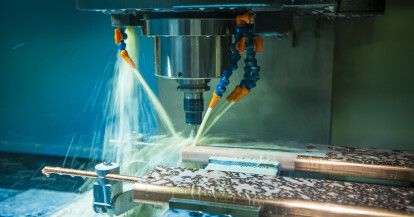Aluminium and copper components in the aircraft industry

The materials used in the aircraft industry must meet strict requirements: they should be lightweight so that aircraft weight and fuel consumption are reduced.
Furthermore, they must be extremely durable. In addition, they need to be resistant to extreme temperature conditions and chemical substances. The material that meets the above requirements is, among others, aluminium that has been used in the aircraft industry for over 100 years.
Aluminium in the aircraft industry: alloys, applications and properties
Aluminium is one of the main materials used in the aircraft industry, and it is estimated that the average aircraft may consist of 70% of this metal.
In general, this material is used in the aircraft industry as various alloys (rarely as pure aluminium), and their basic component is copper. Aluminium alloyed with silicon, manganese, magnesium and zinc are also used. In most cases, these are: duralumin, avional and silumin. Upon annealing, their strength is enhanced and several times higher than that of pure aluminium.
Duralumin, avional and silumin: aircraft construction materials
-
Duralumin is a multi-component alloy of aluminium, copper (up to 4.9%), magnesium and manganese (sometimes silicon and iron are also added), intended for plastic forming. This alloy is characterised by its very good mechanical properties and stress cracking resistance. In addition, it has a low specific gravity (2.8 g/cm³). Duralumin is used for building high-strength construction materials for aircraft.
-
Avional is another aluminium alloy used in the aircraft industry intended for plastic forming that mainly consists of copper (about 4%). In turn, silumin is a casting alloy that is based on silicon (about 12%) with additives of copper, magnesium, manganese and nickel. It is characterised by very good casting properties and high corrosion resistance.
Copper in the aircraft industry: excellent electrical and thermal conductivity
Copper, like aluminium, is an essential component of an aircraft. It has many unique properties. First of all, copper is a very good electrical and thermal conductor. At the same time, copper is incredibly durable and corrosion-resistant. This metal has been, is and will be used in the aircraft industry as there is no other substitute having similar properties.
It should be known that the production of components (copper and others) for the aircraft industry is related to meeting very strict quality criteria and obtaining a special ISO 9001 certificate. The requirements of the standards must not only be implemented and verified, but also properly recorded.

What other metal could be used in aircraft that has similar properties to aluminium?
Aluminium and its alloys and composites are the most frequently used materials in the aircraft industry, but this is only a tiny part of all the raw materials used in this industry! Engineers are constantly developing new materials that are lighter but more durable. Nowadays, polyamides and carbon nanotubes, for instance, are used. Stainless steel is also applied to some extent (for instance, as parts for an engine or turbines).
On the other hand, aluminium is used to produce the majority of aircraft components, starting from fuselages and wings, through exhaust pipes and ending up with seat structures.
Electris components in the aircraft industry
Electris is an expert in the prototyping and production of specialised copper components for among others, the aerospace industry. We also produce complex aluminium components in our highly advanced machinery facilities. Electris specialises in prototyping and mass production.
We actively participate in the development of industry innovations. We are proud that our company contributes to the creation of top-level and high-precision copper and aluminium components.



